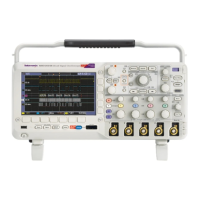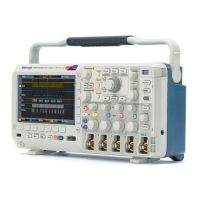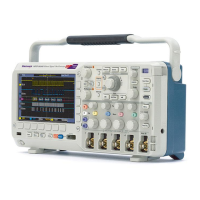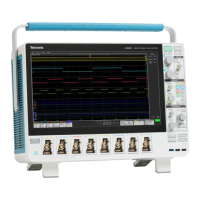Button Description
Level Sets the amplitude level that the signal must pass through to be considered a valid transition. The
color of the Level knob LED indicates the trigger source except for dual-level triggers. The Level knob
is not available when the trigger type requires two level settings or other trigger qualifiers (set from
the T
rigger configuration menu). Push the knob to set the threshold level to 50% of the peak-to-peak
amplitude range of the signal.
Mode Sets how the instrument behaves in the absence or presence of a trigger event.
Auto trigger mode enables the instrument to acquire and display a waveform whether or not a
trigger event occurs. If a trigger event occurs, the instrument displays a stable waveform. If a trigger
event does not occur, the instrument forces a trigger event and acquisition and displays an unstable
waveform.
Normal trigger mode sets the instrument to acquire and display a waveform only when there is a valid
trigger event. If no trigger occurs, the last waveform record acquired remains on the display. If no last
waveform exists, no waveform is displayed.
Horizontal Position Moves the waveform and graticule side to side on the screen (changing the trigger point position in the
waveform record). Push the knob to center the trigger event to the center graticule on the Waveform
view.
Horizontal Scale Sets the time per major horizontal graticule division and samples/second parameters for the
oscilloscope. Scale applies to all waveforms. Push the knob to enable the Fine mode for making
smaller increment changes. Push the knob again to close Fine mode.
Vertical Position Moves the selected waveform (Channel, Math, Reference, Bus) and its graticule up or down on the
screen. The color of the knob indicates which waveform the knob is controlling. Push the knob to set
the threshold level to 50% of the peak-to-peak amplitude range of the signal.
Vertical Scale Sets the amplitude units per vertical graticule division of the selected waveform. The scale values are
shown on the right edge of the horizontal graticule lines, and are specific to the selected waveform in
both Stacked or Overlay modes (in other words, each waveform has its own unique vertical graticule
settings regardless of display mode). The color of the knob indicates which waveform the knob is
controlling.
Channel buttons Turn on (display), select, or turn off Channel, Math, Reference, or Bus waveforms. The number of
channel buttons depends on the instrument model. If the channel is not displayed, pushing a Channel
button turns on that channel to the Waveform view. If the channel is on the screen and is not selected,
pushing that channel's button selects that channel. If the channel is on the screen and is also selected,
pushing that channel's button turns that channel off (removes it from Waveform view).
Math Adds or selects a Math waveform on the Waveform view. If no Math waveform exists, pushing the
Math button adds a Math waveform to the Waveform view and opens the Math configuration menu. If
only one Math waveform is displayed, pushing the button turns off the Math waveform (removes it from
Waveform view). Push the button again to display the waveform. If two or more Math waveforms are
displayed, pushing the button cycles through selecting each math waveform.
Ref Adds or selects a Reference (saved) waveform on the Waveform view. If no Reference waveform
exists, pushing the button opens the Browse Waveform Files configuration menu. Navigate to and
select a waveform file (*.wfm) and tap Recall to load and display the reference waveform. If only one
Reference waveform is displayed, pushing the button turns off the Reference waveform (removes it
from the Waveform View). Push the button again to display the waveform. If two or more Reference
waveforms are displayed, pushing the button cycles through selecting each Reference waveform.
Table continued…
Getting acquainted with your instrument
2 Series Mixed Signal Oscilloscopes MSO24, MSO22 Quick Start Manual 21

